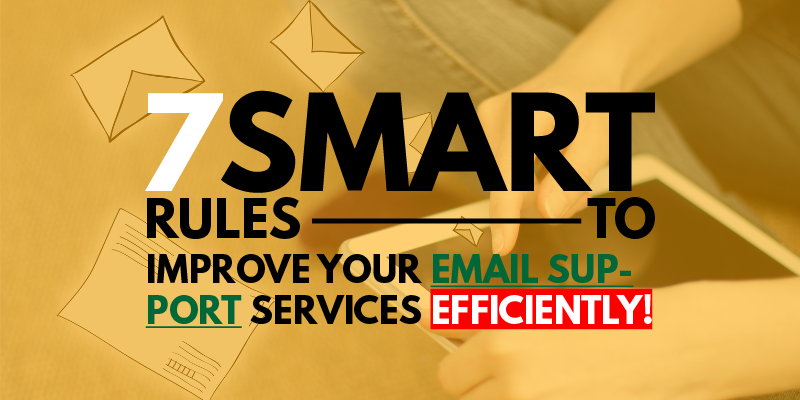Customer satisfaction has always been one of the most promising factors in deciding your brand’s fate. Email support is one way that has been handling customers efficiently for a very long time now. Every customer service channel must provide excellent CX and increase loyalty for your company.
Businesses that do not use mail support are missing out on many opportunities. You can foster lasting relationships with clients with the help of email. People are more inclined than ever to reach out for help. With a quick email, you can give the solution or information your customers want without having them go through the hassle of a phone call.
Email can be a powerful tool for business, but many companies do not know how to use it. It remains one of the most common channels, used by more than 57% of customers. You would be surprised to know only 20% are fully utilizing its potential as an effective customer service channel.
How can you make your emails more effective? There are many ways, but we bring the top seven ways you can improve it. Let’s read how you can utilize this valuable tool to your benefit:

7 Smart Rules for Improving Business Email Support
- Personalize Your Customer Support Style
- Send Tailored Emails
- Symmetry Between Automation and Real Agent
- Acknowledge and Restate Customer Issues
- Practice the ELI5 Method
- Redirect Customers to Useful Content
- Always Request Feedback
1. Personalize Your Customer Support Style:
You must establish the tone of voice for your brand. This will allow everyone on the team to use similar language and communicate in an engaging way with customers, which reflects positively on your company. It is what reflects the personality and culture behind your brand. A standard, on-brand tone ensures consistency across all channels.
It would be best to ask yourself the following questions to decide your tone:
- Does your reply require a conversational or professional tone?
- Which style or tone is more appreciated by your client?
- What is the timeframe for responding and resolving issues?
- In what manner would you address a problem when consumers require service outside standard hours?
In order to provide the best customer service, you need a set of rules and guidelines that your team can use. First, create an internal style guide so everyone knows what is expected from them. Then, take time to think about the kind of tone you want your customer service should stick to. Everyone following the same guidelines will create consistency in your operations.
2. Send Tailored Emails
One of the worst things in email is when it feels like you are talking to a bot. Make sure your customer knows they are dealing with someone real and not just another automated response machine.
There is a reason that customer service has become such an essential part of doing business. When buyers feel they are getting personal attention and quality information, their confidence in what you have to say grows considerably. It means better relationships with them in the long run. You can hire an outsourcing company that knows how to nurture customer relations perfectly.
Familiarity is established by including your and their name in the email. For an even more personal touch, use any greeting or other phrases that are unique to them. In addition, your signature can help humanize the interaction. So, send a tailored email to engage consumers better.
3. Symmetry Between Automation and Real Agent
In these times of stress, finding the right time to know when to use automation and when to personalize is vital. Many times an event occurs in which your support agents can’t respond to clients right away. It could be because of any technical glitch or a long queue. In such scenarios, using canned and automated replies will help quell your customer’s concerns.
Outsource support 24/7 live email agents to keep things running smoothly without disruption during peak times. Your performance may suffer otherwise because everyone has something they want to be resolved quickly, no matter what hour it is.
With auto-responders, you can quickly and efficiently answer frequent customer problems. Your team can save a lot of time each day by using it. However, make sure to personalize the messages to each individual’s needs.
4. Acknowledge and Restate Customer Issues
The best way to solve a customer’s problem is by emailing them back and forth until they are satisfied. First of all, acknowledging their concern ensures that you understand what has been going on with your client’s complaint. Next, showing empathy might alleviate their anger and make them feel like they are being heard.
Maintaining an optimistic tone for your email support is imperative. It will help keep customers happy and give them the impression that their problem matters to you and is not just an empty shell of someone who can’t be bothered.
5. Practice the ELI5 Method
The ELI5 (Explain Like I’m 5) method is a simple practice to make sure you are explaining things in the simplest and most engaging manner. If your customer does not understand something, use this approach. Then, they will be likelier to listen or remember what that solution does.
To make complex topics easier to comprehend, break them down into simple instructions and explain them with images or videos. The ELI5 practice is a great way to help customers understand your instructions better. Remember, they are coming from somewhere there is something that does not make sense. So be patient and use simple language.
6. Redirect Customers to Useful Content
As a business, you need to give your customers plenty of ways for them not only to have access but also the time required to digest all that information. This includes providing clear instructions and displaying graphics along with other visual aids such as videos or images to ensure every aspect has been covered.
Keep your emails short and sweet. Research has shown that people do not like reading long messages on their phones. So try linking to the full instructions in a concise email. Then, the customer will be able to follow the instructions you have provided in a more helpful way when they log on to their system.
You want to teach your customers how they can take care of themselves and their needs. So, if your customers ever find themselves in a position where a similar problem occurs, they would know what exactly to do without contacting email support again.
7. Always Request Feedback
When you resolve a customer’s concern, ask them what they think. This will not only provide insight on how your emails could be improved from the perspective of someone who has received it, but it also lets those involved know that we care. Let them know what actions speak most effectively with customers.
Keep Your Customers Happy with DOS
Email customer support is a must for online as well as brick-and-mortar businesses. Wait times have been long enough that people are no longer willing to wait on the phone. The only thing that can make up for its loss is emails. With so much competition in today’s marketplace, it pays off to have an amazing experience with your customers.
Digitech Outsourcing Solution (DOS) brings the best email support services to empower your business. Our quality representatives understand your business and manage your operations under the same model. Our email agents work 24/7 to make sure your business serves the global market. You can also use our trail option to find out more about our services. So, it would be great to reach out today and personalize a plan in line with your business requirements.




